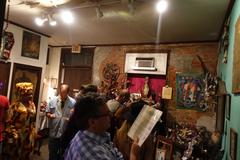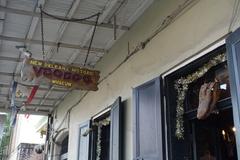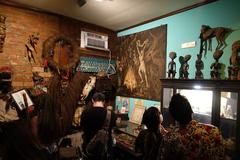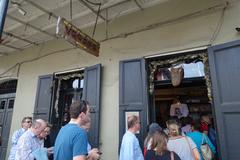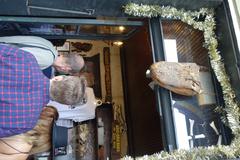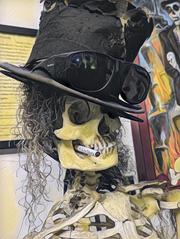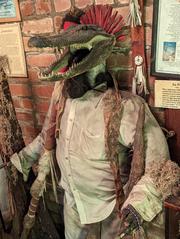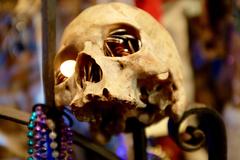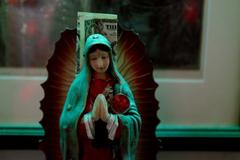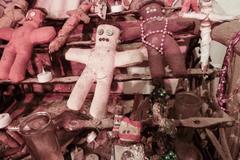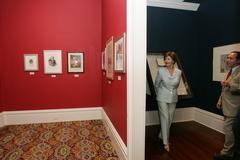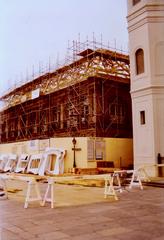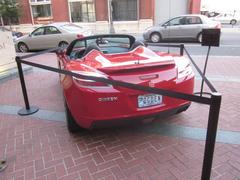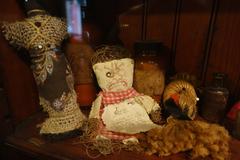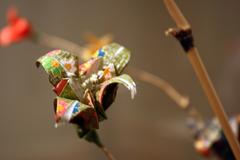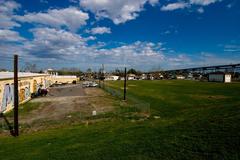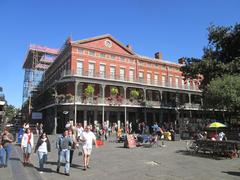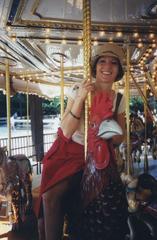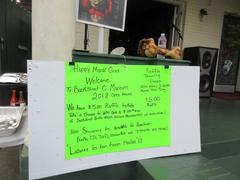
New Orleans Historic Voodoo Museum Visitor Guide
Date: 18/07/2024
Introduction
Nestled in the heart of the French Quarter, the New Orleans Historic Voodoo Museum offers a unique glimpse into the mystical and often misunderstood world of Voodoo. Founded in 1972 by Charles Massicot Gandolfo, the museum aims to demystify and preserve the legacy of Voodoo in New Orleans, a city where the religion has deep historical roots and cultural significance. Visitors can expect to delve into the origins of Voodoo, which trace back to West African spiritual traditions brought to the New World through the transatlantic slave trade. These beliefs intertwined with Catholic traditions and indigenous practices, evolving into what is now known as Louisiana Voodoo. The museum also highlights influential figures such as Marie Laveau, the legendary Voodoo priestess whose impact on the community continues to be felt today (source). Whether you’re a history enthusiast or a curious traveler, the New Orleans Historic Voodoo Museum offers an educational and captivating experience that challenges sensationalized portrayals and emphasizes the religion’s true nature focused on healing, guidance, and community.
Table of Contents
Historical Background and Cultural Significance
Origins of Voodoo in New Orleans
Voodoo, also spelled Vodou or Vodun, found its roots in West African spiritual traditions, particularly those of the Fon and Yoruba people of present-day Benin and Nigeria. The transatlantic slave trade brought these beliefs to the shores of the New World, where they intertwined with Catholic traditions and indigenous practices, evolving into what we now know as Louisiana Voodoo.
New Orleans, with its significant enslaved African population and its position as a cultural melting pot, became a fertile ground for Voodoo to take root and flourish. Despite facing persecution and misrepresentation, the religion persisted, becoming an integral part of the city’s social fabric.
Marie Laveau - The Queen of Voodoo
No discussion about New Orleans Voodoo is complete without mentioning Marie Laveau (source), a free woman of color who became a legendary Voodoo priestess in the 19th century. Laveau’s charisma, knowledge of herbs and remedies, and reputation for spiritual power drew followers from all walks of life, including enslaved people, white socialites, and even politicians.
While some accounts portray Laveau as a cunning businesswoman who capitalized on superstition, historical evidence suggests she was a respected community leader and healer who used her influence to advocate for social justice and aid those in need. Her tomb in St. Louis Cemetery No. 1 remains a pilgrimage site for those seeking her blessings or guidance.
The Museum’s Role in Understanding Voodoo
The New Orleans Historic Voodoo Museum, established in 1972 by Charles Massicot Gandolfo, aims to demystify and preserve the legacy of Voodoo in New Orleans. Located in the heart of the French Quarter, the museum occupies a former tenement building, adding to its aura of mystery and authenticity.
Inside, visitors encounter a dimly lit labyrinthine space filled with a fascinating, if somewhat overwhelming, collection of artifacts, altars, and displays. Gris-gris (protective charms), statues of deities, ritual objects, and portraits of prominent figures in Voodoo history offer glimpses into the religion’s practices and beliefs.
Dispelling Myths and Misconceptions
The museum plays a crucial role in challenging the sensationalized and often inaccurate portrayal of Voodoo in popular culture. Hollywood movies and sensationalized stories have often depicted Voodoo as a dark and malevolent force involving curses, hexes, and sinister rituals.
In reality, Voodoo, at its core, emphasizes a connection with spirits, respect for ancestors, and the balance between the physical and spiritual realms. While it acknowledges the existence of both good and evil, it primarily focuses on healing, guidance, and community.
Visitor Information
Ticket Prices and Opening Hours
The New Orleans Historic Voodoo Museum is open daily from 10 AM to 6 PM. General admission is $10 for adults, $8 for students and seniors, and $5 for children under 12. Special group rates are available upon request.
Travel Tips and Nearby Attractions
The museum is located at 724 Dumaine Street, making it easily accessible from various parts of the city. Nearby attractions include the French Quarter, Jackson Square, and the St. Louis Cathedral. Combining your visit to the museum with these sites can make for a fulfilling day of exploration.
Accessibility and Special Events
The museum is housed in an older building, which may present some accessibility challenges. It’s recommended to contact the museum in advance for specific accessibility inquiries. The museum occasionally hosts special events and exhibits, so check their website or contact them directly for the latest information.
Guided Tours and Photographic Spots
While the museum does not offer guided tours, the staff, often practitioners of Voodoo themselves, are available to answer questions and provide insights. Photographic spots within the museum include the intricate altars and displays of ritual objects, which provide a vivid representation of Voodoo practices.
FAQ Section
Q: What are the New Orleans Historic Voodoo Museum visiting hours?
A: The museum is open daily from 10 AM to 6 PM.
Q: How much are tickets for the New Orleans Historic Voodoo Museum?
A: General admission is $10 for adults, $8 for students and seniors, and $5 for children under 12.
Q: Is the New Orleans Historic Voodoo Museum accessible?
A: The museum is located in an older building, so accessibility may be limited. It’s advisable to contact the museum directly for specific accessibility information.
Q: Are there guided tours available?
A: The museum does not offer guided tours, but staff members are available to answer questions and provide information.
Conclusion
The New Orleans Historic Voodoo Museum offers a fascinating journey into a vital aspect of the city’s cultural heritage. By visiting, you can gain a deeper understanding of Voodoo’s role in New Orleans’ history and its ongoing cultural significance. Remember to approach with respect and an open mind to fully appreciate this unique experience.
Call to Action
To learn more about the New Orleans Historic Voodoo Museum, visit their official website. For more insights into New Orleans’ rich cultural heritage, check out our other articles and follow us on social media for updates and travel tips.
References
- Exploring the New Orleans Historic Voodoo Museum - History, Tickets, and Visitor Tips, 2024, source
- A Guide to Visiting the New Orleans Historic Voodoo Museum - Exhibits, History, and Visitor Information, 2024, source
- New Orleans Historic Voodoo Museum - Visiting Hours, Tickets, and Essential Visitor Information, 2024, source
- Marie Catherine Laveau, National Women’s History Museum, source
